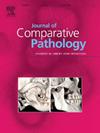Clinicopathological characterization of sinonasal sarcomas in dogs
IF 0.8
4区 农林科学
Q4 PATHOLOGY
引用次数: 0
Abstract
The nasal cavity and paranasal sinuses comprise various tissues that can give rise to different neoplasms, including nasal sarcomas. The aim of this study was to describe the clinicopathological characteristics of canine sinonasal sarcomas. A retrospective study was conducted on 39 dogs, aged between 2 and 18 years old, with a diagnosis of sinonasal sarcoma. The dogs were grouped according to tumour type: 12 nasal chondrosarcomas, 12 osteosarcomas and 15 spindle cell tumours (fibrosarcoma, undifferentiated sarcoma, haemangiosarcoma, myxosarcoma and leiomyosarcoma). Most dogs were mixed breed and there was a predominance of large breeds in the cases of nasal osteosarcoma. Facial deformity, epistaxis and dyspnoea were the most common clinical signs. The tumours affected mainly the nasal region. Metastases were uncommon and found in three cases of nasal spindle cell tumour and one case of chondroblastic osteosarcoma. Furthermore, nasal spindle cell tumours had an increased mitotic index, compared with chondrosarcoma and osteosarcoma, suggesting malignancy.

犬鼻窦肉瘤的临床病理特征
鼻腔和鼻窦由各种组织组成,这些组织可以产生不同的肿瘤,包括鼻肉瘤。本研究的目的是描述犬鼻窦肉瘤的临床病理特征。回顾性研究对39只年龄在2至18岁之间,诊断为鼻窦肉瘤的狗进行了研究。按肿瘤类型分组:鼻软骨肉瘤12例,骨肉瘤12例,梭形细胞肿瘤(纤维肉瘤、未分化肉瘤、血管肉瘤、黏液肉瘤、平滑肌肉瘤)15例。大多数犬为混合品种,鼻骨肉瘤病例中以大型犬为主。面部畸形、鼻出血和呼吸困难是最常见的临床症状。肿瘤主要影响鼻腔区域。转移不常见,在3例鼻梭形细胞瘤和1例成软骨骨肉瘤中发现。此外,与软骨肉瘤和骨肉瘤相比,鼻梭形细胞肿瘤有丝分裂指数增高,提示其为恶性肿瘤。
本文章由计算机程序翻译,如有差异,请以英文原文为准。
求助全文
约1分钟内获得全文
求助全文
来源期刊
CiteScore
1.60
自引率
0.00%
发文量
208
审稿时长
50 days
期刊介绍:
The Journal of Comparative Pathology is an International, English language, peer-reviewed journal which publishes full length articles, short papers and review articles of high scientific quality on all aspects of the pathology of the diseases of domesticated and other vertebrate animals.
Articles on human diseases are also included if they present features of special interest when viewed against the general background of vertebrate pathology.

 求助内容:
求助内容: 应助结果提醒方式:
应助结果提醒方式:


